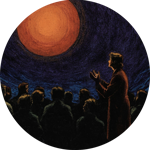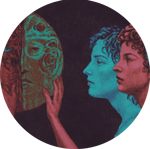Craft, Concept, Algorithm
I must start by noting the strangely elegiac tone that has crept into our culture’s discussions of the automation and degradation of its own labor. Even as the means of production slip through our hands into the tentacles of globalized techno-capital, we find ourselves eulogizing not only the fate of labor, but also that of art, which for centuries has been closely allied with production. I speak not as a Marxist, but rather as an artist and enthusiast for art and design: it saddens me greatly to contemplate a world without art and design as we know it—as something created and consumed by living human beings. There is no question that our era will go down in history as the point where human art was systematically and efficiently destroyed. This is not wistful nostalgia: there are already good arguments being made that art as we have known it for centuries has effectively died, replaced by AI-generated approximations and the shoddy mass production of human labor.
Over the course of the twentieth century, the conditions of artistic production changed drastically. Up until the 1950s and 1960s, artistic creation was a craft, based in studio-practice, the apprenticeship of traditional media, and a dialogue with predecessors deeply grounded in both historical and material conditions. The young artist had to spend time learning how to use specific tools and materials, developing skill through labor and discipline. (In ancient Greece the term for “artist” was tekhton—i.e. “craftsman.”) This was true of both visual and literary art: the poet had to learn about the sounds of words, the illustrator movements of ink on paper; the painter colors and pigments; the sculptor chiseling stone. To be an artist meant immersing oneself in a concrete tradition—spending years learning not just the theory, but the physical techniques of a craft. Even “experimentation” was based on what the material offered, its limitations as much as its potential. Art was a question of craft and connoisseurship, the materiality of both the means of production and the work itself.
With the advent of photorealism and conceptualism, this all changed. Art was divorced from both the historical and the concrete—from material techniques, from tradition. The craft of the artisan was replaced by the quick-and-easy of the mass-producer. As we entered a new, abstracted relationship with art and design—where what mattered was not so much the creation of a specific object but rather the expression of some idea or “message”—it became easier to produce “art.” The division of labor in the artworld made it so that what mattered less was whether an “artist” had actually created the thing and more on the intentions or meanings expressed by that person in relation to their public.
With this shift away from art as an object, towards art as an event or a sign, we began the process of automating art. Already, back in the 1960s and 1970s, you didn’t need to know much about making a painting or writing a story to get a painting or story into a museum or gallery. You were more likely to be included in the “canon” of avant-garde artists if what you made was strange or illegible to a mainstream audience, because it signified you were doing something truly new. It no longer mattered that the creator knew how to use traditional media to craft something of high quality, since the focus had shifted towards novelty, surprise, and self-expression. What mattered most was having connections.
What all this meant was that there was less need for the creative worker to possess deep knowledge of either materials or audience. She didn’t need to learn how to make a thing, since what was being produced was primarily a sign—a marker of the creator’s position within some theoretical field. She didn’t need to know how to work a medium, since it didn’t matter if her work was well made. And she didn’t need a personal relationship with the public, because the work of art was understood primarily as an act of self-expression—and what matters most about expression is not whether the message is clear, but whether it is true.
If I must make a claim about “reality,” it is this: a sign can only truly communicate when it corresponds to the reality it purports to describe. When we talk about “authentic” expression in art, we must bear in mind that these words only make sense within a framework where some kind of transcendent meaning can exist independent of any particular expression—which means there must also be bad expression. The worse the expression, the further it drifts from the original truth. Bad expression is the hallmark of ideology. If an ideology is any system in which the relationship between a sign and the reality it represents is broken (so that the sign comes to signify itself), then false consciousness is a signifier with no connection to any particular reality. In such a case, “authentic expression of truth” would be that expression with a strong correspondence to the thing itself—one that expresses an idea in terms that could only make sense in reference to a real state of affairs. This is what we mean by “good writing”—there is no mystery, no magic. There is only correspondence. “Authentic” art is thus an expression which could be communicated in no other way.
But this is just what abstracted, theoretical art and design are not—because they are based not on any idea logically tied to a specific form, but rather on an abstract concept which could be expressed through an infinity of different means. The importance of any given sign in such a system is not its correspondence to anything outside the system (since there is nothing outside it that the sign could correspond to). What is at stake is not whether the sign expresses something true, but rather its role within the structure of the system—its use-value, its relation to other signs in terms of power and authority, etc.
When an artist operates in a system such as this, her first task is always to insert herself into existing power relationships. She does so by making the “correct” conceptual decisions (e.g., “this will be about my sexual identity,” or “this is to be a political work”—broad statements that situate her work in relation to all other work within the field). After establishing herself within a network of social, political, or ideological relationships, the question of whether her work is well made becomes increasingly unimportant, so long as it appears to fit into the accepted paradigm. The keyword is “fit”—it is far more important to produce an object that has the proper social, political, or philosophical message and functions adequately within its predetermined niche than to produce something beautifully designed, masterfully painted, or clearly written.
It is here that we can see most clearly the shift from art as object to art as event, and with it the rapid disappearance of human art. The whole question of artistry has become irrelevant. Now art can be mass produced in factories around the world without anyone caring if what is made is actually any “good.” And who is “the public” for this work? There is no clear answer. Since what is being offered is not a specific thing but an idea, an interpretation of reality, “the public” is anyone who may come into contact with this work—regardless of whether they wanted to see it. There is no way for “the public” to avoid being confronted by it, since the whole of everyday life has become a kind of gallery where works of art (i.e., messages) can appear anywhere at any time. There are no limits. Even “high” culture has become democratic and debased, so that works which previously could be appreciated only by those who had trained their senses are now blasted at us from billboards, the Internet, and public spaces, with no opportunity for retreat. What has happened is the final death of the idea of beauty in our culture: for beauty always requires a certain “distance,” a certain selectivity, which has now been entirely lost.
With this context, we may better understand the rise of “AI art”—in an artistic production which no longer has any concrete, specific existence and in which the “public” has been thoroughly disenfranchised. We should not be surprised to find a culture where nothing is valued unless it can be instantly reproduced by machinery, for it is this same process that has degraded artistic production as we have known it. But it would be a mistake to assume that AI art is merely the product of a social and technological evolution that had already destroyed art as something precious. AI art is also—and above all—the product of an urgent, active desire for the destruction of art: the wish of those who would seek to control every aspect of social life to extinguish any source of resistance, autonomy, or spontaneity; to control the meaning and content of even those things most closely bound up with human identity—like imagination.
If we are not to believe the hype, we must remember that AI art has no other purpose than to replace what we call art—which has for centuries been an essential element of what we mean by human. “Art” is not just making pretty things—it is essential to human society, since it is a process in which human beings have the chance to break out of the prison of what is socially permissible, to experience the infinite, the transcendent, and the forbidden, without having to go through the potentially catastrophic process of social “rebellion.” But those who wish to abolish the autonomous sphere of the imaginary have realized they must move fast: while the technical means for replacing art with machine-made imitations are recent, the cultural ground is already prepared—it is a sign of our decadence that people are eager for even the smallest opportunity to relinquish autonomy in their experience, and to surrender to the logic of the machine.
We are not talking just about replacing skilled human labor with some machine process; we are talking about the eradication of art as one of the primary human activities that give shape, meaning, and beauty to life, and its replacement with processes that will be even more machine-oriented, even more alien to the concrete reality of lived experience than anything we have known until now, precisely because they will no longer have any relationship to any human imagination. When we hear people say “art is dead,” we should take this as a very literal statement: “art” is not a human activity anymore; “artists” no longer have meaning. Because if we are to believe these people, nothing can be said to have artistic value if it may also be made by a machine—machines which will supposedly be able to “outthink,” “outimagine,” and “outcreate” human beings at everything. What these people really want to destroy is not art—which they think can be done by letting machines do the work—but imagination, because they know that if machines can produce things indistinguishable from “art,” it will no longer be possible for any human to claim that their imagination is in any way special, or worth attention.
Let me summarize. We live in a world where art is increasingly being replaced by what is made by AI, but at the same time the concept of “art” itself (the autonomous sphere of imagination, beauty, and transcendence tied to the concept of “humanity”) is already disintegrating. The destruction of art is under way in two different ways simultaneously.
There is thus a twofold danger: on one hand, there is the threat of being totally subsumed by “the system,” of having no freedom left, of being alienated from life, work, and society. But this is just what many artists—at least since Dada and Surrealism—have already tried to do away with by producing works that have no clear place in the existing structure. Yet there is also a second danger: that of imagining there is an autonomous sphere of art when, in reality, what is called art is increasingly the product of machinery and functions, in every aspect of its production and reception, within a totally administered environment—an environment which is itself modeled after art, concerned to present itself as a kind of spectacle. The question for the future will not be whether “art” can “fight back,” since there is already so much that is not “art” (even if it looks like it) that it has become impossible to determine clear battle lines. Instead of imagining that art is “dying,” we should see what new forms of “non-art” (propaganda, entertainment, political indoctrination) are taking over what used to be the role of art, so that we can better understand where the real struggle is taking place, and how we might intervene.
If I may now speak to those of you who, like me, are still practicing artists: do not think for one second that you are making any “important contributions to humanity” when you make art. The fact that you are dealing with beauty, with form, with the imaginary is just a reflection of the fact that your social function is to remain in “play mode” as much as possible—to help others forget (for a moment) about the alienation, exploitation, and destruction that characterize their everyday lives, to allow them a glimpse into “a world that could be” if it were not so thoroughly dominated by commodity exchange. So do not mistake the relative autonomy of your work for “significance” or “importance.” Instead, be grateful that you are not asked to do any “serious work”—like engineering a weapon or devising new ways to extract surplus value from an increasingly proletarianized labor force—and use this relative freedom wisely, to help keep alive (if only in the imaginary realm) the dream that some other, better world might yet be possible.
The situation is like this: you find yourself trapped on a sinking ship—but it turns out the lifeboats have all been converted to waterbeds. So you have two choices: either lie back and enjoy the feel of the rocking waves as they softly caress you from side to side, or get up on the deck, look around you, and try to figure out what the hell went wrong, and what you can do about it.




